Figure 5. Effects of treatment on life history strategies.
Different treatments select for and induce different life history strategies. A. Traditional high dose therapies cause high levels of cell mortality, initially selecting for survival specialists (light blue) but, afterwards, with an abundance of resources and a paucity of competitors, proliferating specialists (pink) gain an advantage, which may contribute to recurrence. B. A treatment that normalizes and limits resources selects for cells with slow life history strategies, specializing on survival and competition (pink), which may facilitate long-term cancer control. C. Cells with conditional life history strategies may respond to cytotoxic therapies by shifting first into a survival phenotype (blue) and then back into a rapidly proliferating phenotype (red), which may lead relapse. D. When exposed to a therapy that establishes a constant environment with limited yet stable resources, cells with conditional life history strategies may shift into a slow life history phenotype that invests cellular resources into survival and competition (blue), which may enable long-term cancer control.

